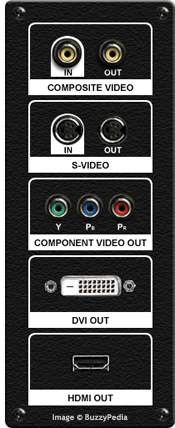
Even though the information (the movie) on a DVD is stored digitally, it all depends on your TV how the DVD player will send this information to your TV. Old VCRs acted like a "Channel" and you had to
tune your TV to your VCR channel. This presented many problems (one of them being other channels interfering resulting in a less than satisfactory quality) and it didn't take long for TV and VCR manufacturers to come up with a new way of hooking up a VCR to the TV.
Instead of taking the analog signal from the VCR and "modulating" this over a channel together with the audio, they separated the audio from the video and sent both signals directly to your TV. The nice thing was that this new incoming signal would completely bypass the TVs tuner, and no longer were other channels able to interfere nor was the audio able to interfere with the video. This was called
Composite Video (CV) and is still widely used today.
Even though this method was a big improvement, it's shortcomings would soon be exposed as TVs became better at displaying pictures.
The problem with CV was that all video information was sent over a single wire, and the TV had a hard time separating this signal in its components (Red, Green and Blue) because at certain levels (for instance, a very dark color) the TV had a hard time deciding what color it actually was. The next step up was
S-Video. S-Video separated the color information from the luminance (or brightness of a color). This made it much easier for a TV to determine the
exact color it needed to display and would then overlay the luminance information. The result was a much clearer picture. In fact, S-Video is still the most widely used output type for DVD players. Then came
RGB and
Component Video, which separated the color information even more. Component Video is (arguably) the best of the mentioned display systems but it's not widely supported by TVs. Which one is best for you depends on personal taste. Composite Video should only be used if your TV offers no other option - because the resulting quality is very poor compared to the other standards. But whether S-Video, RGB or Component Video is best for you is a matter of taste since they all have their advantages and disadvantages.
All these systems have one thing in common: it's "analog" information. That means that all information is nothing more than variations in voltages which can be measured accurately, but never precisely because so many outside factors can influence this voltage; like quality of used electronic components in a player and TV, or interference from other nearby electronic equipment, etc. The best analogy (no pun intended) is that "Analog" is like sending a postcard to the other side of the world. Along the way it gets scratched, folded and maybe somebody along the way decides to write something extra on it. When the recipient finally receives the postcard, he can still make out what it is and whom it's from, but he doesn't know what the original state of the postcard was when it was sent. He doesn't know if that writing was on the original or not, or if the sender meant it to be folded like that.
And that's why high-end TVs have a digital input and high-end DVD players a digital output. Using the postcard analogy, the sender doesn't actually send the postcard, but tells the recipient
exactly how the postcard should look and what should be written on it. No information is left out so the recipient is able to reproduce the postcard exactly. In short, no information is lost.
But as always, TVs can use different digital standards while DVD players use only two. DVD players use either
HDMI or
DVI so if you want to hook up your DVD player and TV digitally and don't want to use a converter cable, make sure they match. If the TVís input differs from the DVD player's output make sure a converter cable exists
at all!
Copyright © 2006 - BuzzyPedia.com

